Tahiti – Circling the Island, Part I
This is my fourth post from a recent trip to French Polynesia, but the first one where we actually get down to sightseeing with our Adventures Abroad group led by veteran guide Martin Charlton. In the last post I recommended a self-guided walking tour of Papeete as there is plenty to see there that is not included in the tour we are about to embark upon in this post. We will spend most of today on a tour of the island of Tahiti with our local guide Gerald Mingo. Please join us on the bus as we seek out the reasons why Tahiti is one of those destinations that first comes to mind when one thinks of the attractions of the South Pacific.
Papeete Market
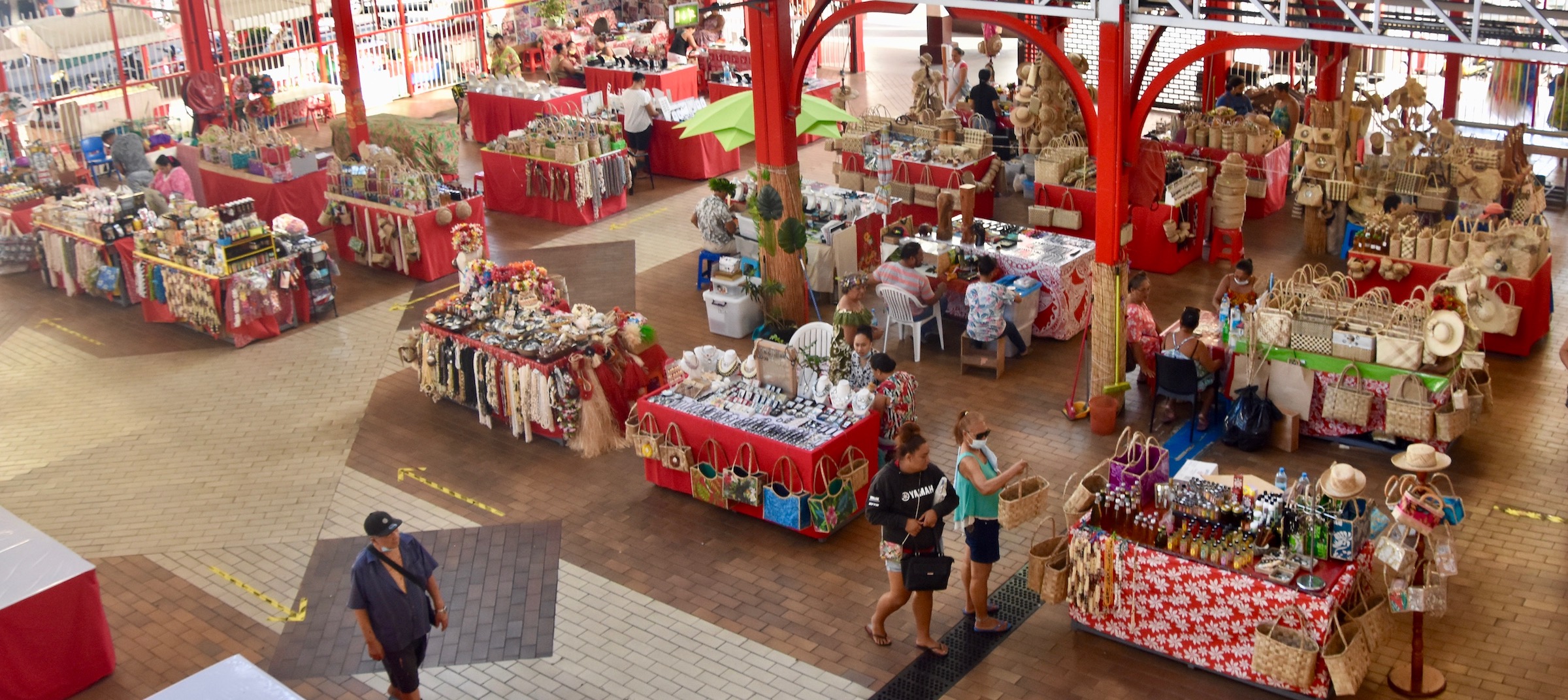
For our first stop we head the short distance into the city of Papeete to visit the market there which is probably the number one tourist site in the city. Thank God there are no cruise ships in port or the place would be a zoo, but as you can see from the picture there are relatively few people about. The market is L-shaped and seems to be divided into two sections, one selling products that are unabashedly aimed at the tourist trade and the other selling fruit, vegetables and other comestibles. While most of the products on the tourist side are mass produced, Gerald points out the difference between the cheaper Tahitian made textiles and the more expensive and glossier looking Chinese knock offs.
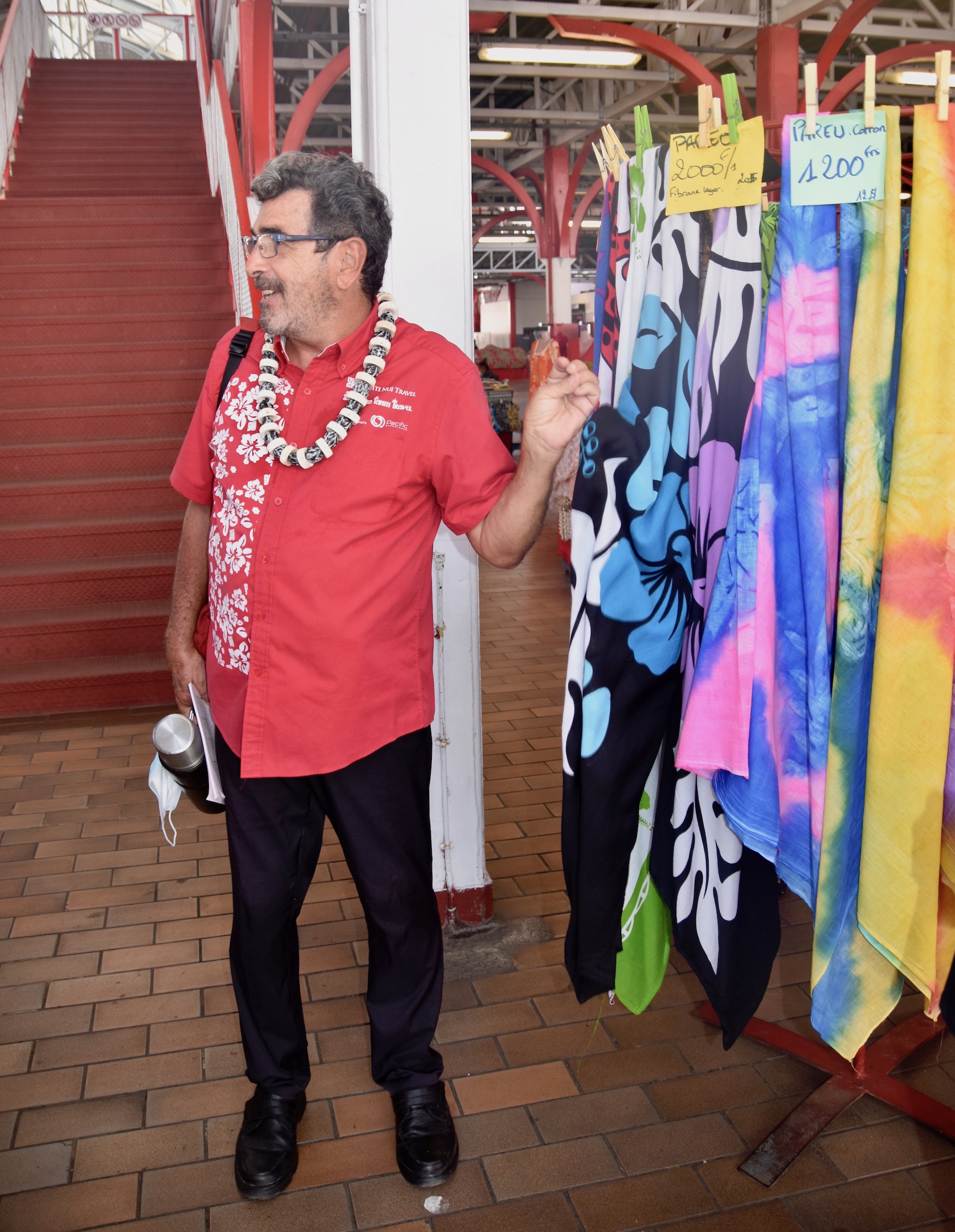
There really is no reason to buy much on the tourist side of the market as there will be much better quality items for sale when we get to the Marquesas Islands later on this tour. However, there are two exceptions. The first is the homemade monoi oil which several vendors are offering at very reasonable prices. This is a strictly Tahitian product that is made by soaking gardenia petals in coconut oil and is used by most Tahitian women as a skin and hair softener. It accounts for the lustrous quality of their dark hair. Alison bought several bottles and is now a monoi oil convert as were several others in the group. It makes a great gift to bring back from Tahiti as it is now legally protected by a French Appellation of Origin and the genuine product only comes from here. 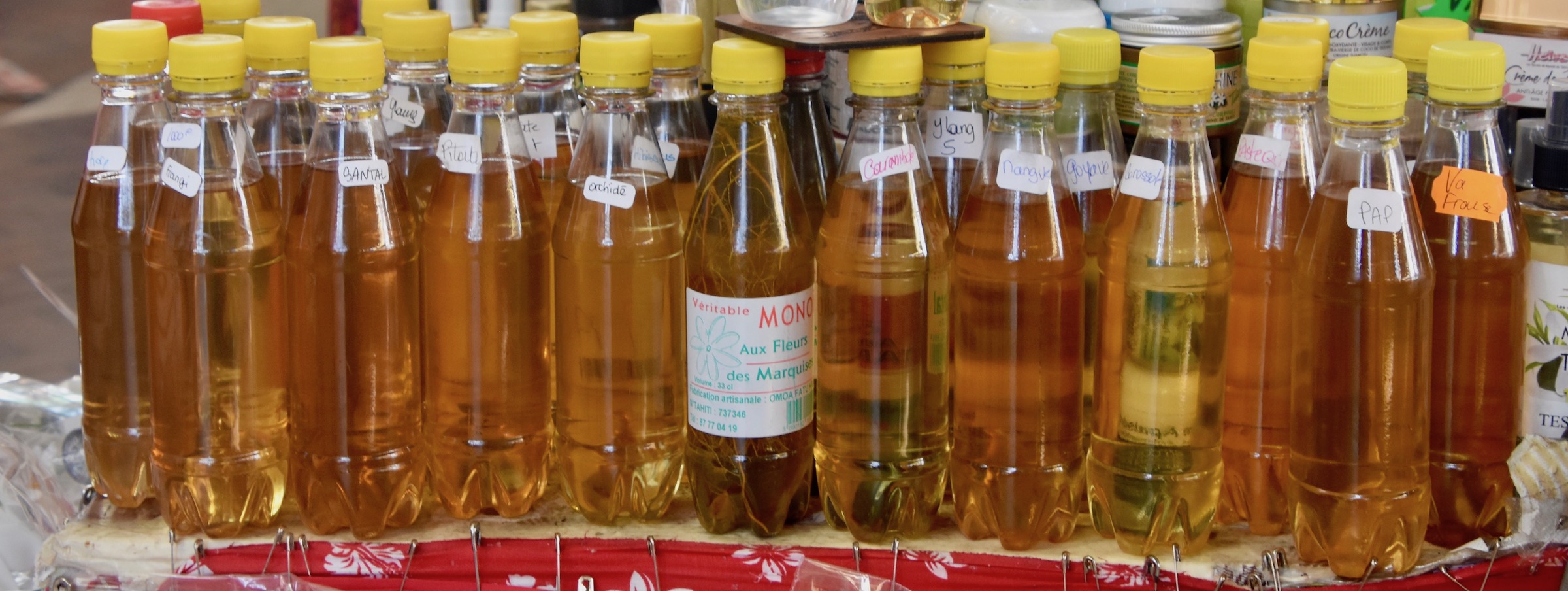 Homemade Monoi Oil
Homemade Monoi Oil
The other things definitely worth looking at, if not buying, are the fantastic leis and floral headbands that I only saw being offered for sale in the Papeete market. They are truly beautiful and make the visit to the market a worthwhile endeavour. Wherever we went in French Polynesia, the women and sometimes the men were often wearing floral headbands. They clearly are not something put on as a clichéd ritual for tourists, but worn because they are a lot nicer than just a hat and smell better too.
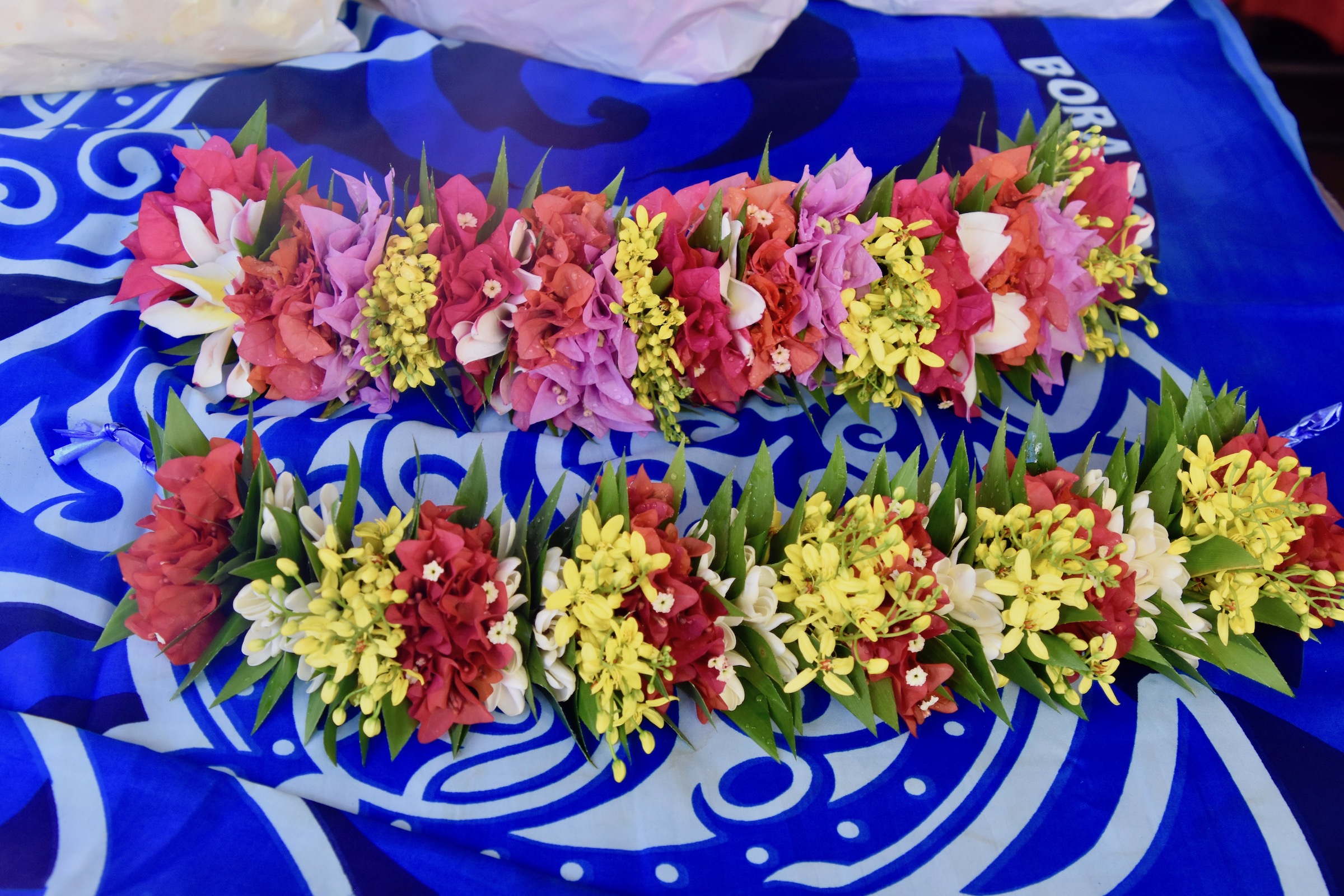
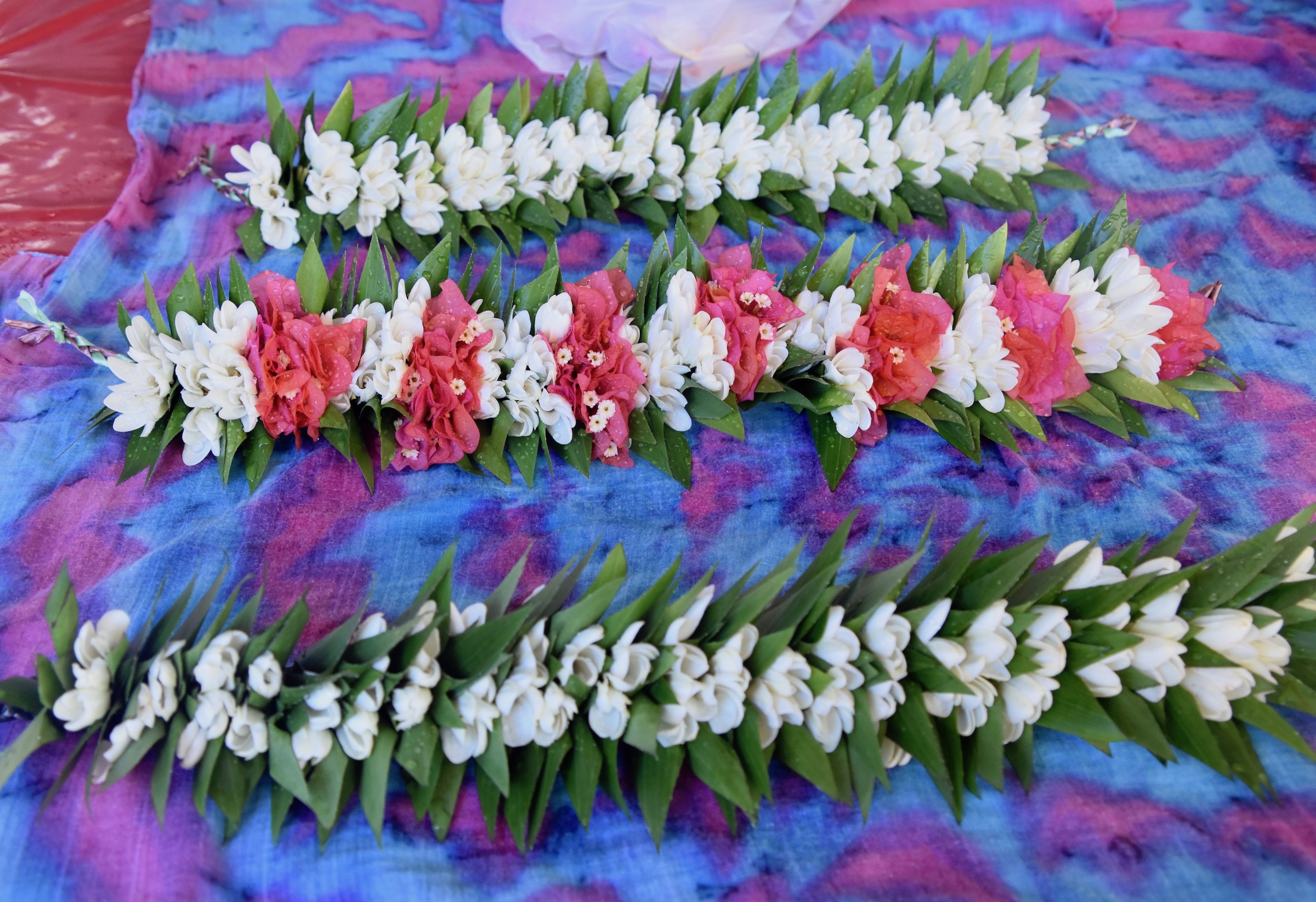
One of the ladies in our group did buy a floral headband and wearing it she very much reminded me of the famous figure of the goddess Flora in Botticelli’s incredible Primavera.
Moving over to the other side of the market you come across locally grown Tahitian fruits and vegetables which are always among the most photogenic items at any market.
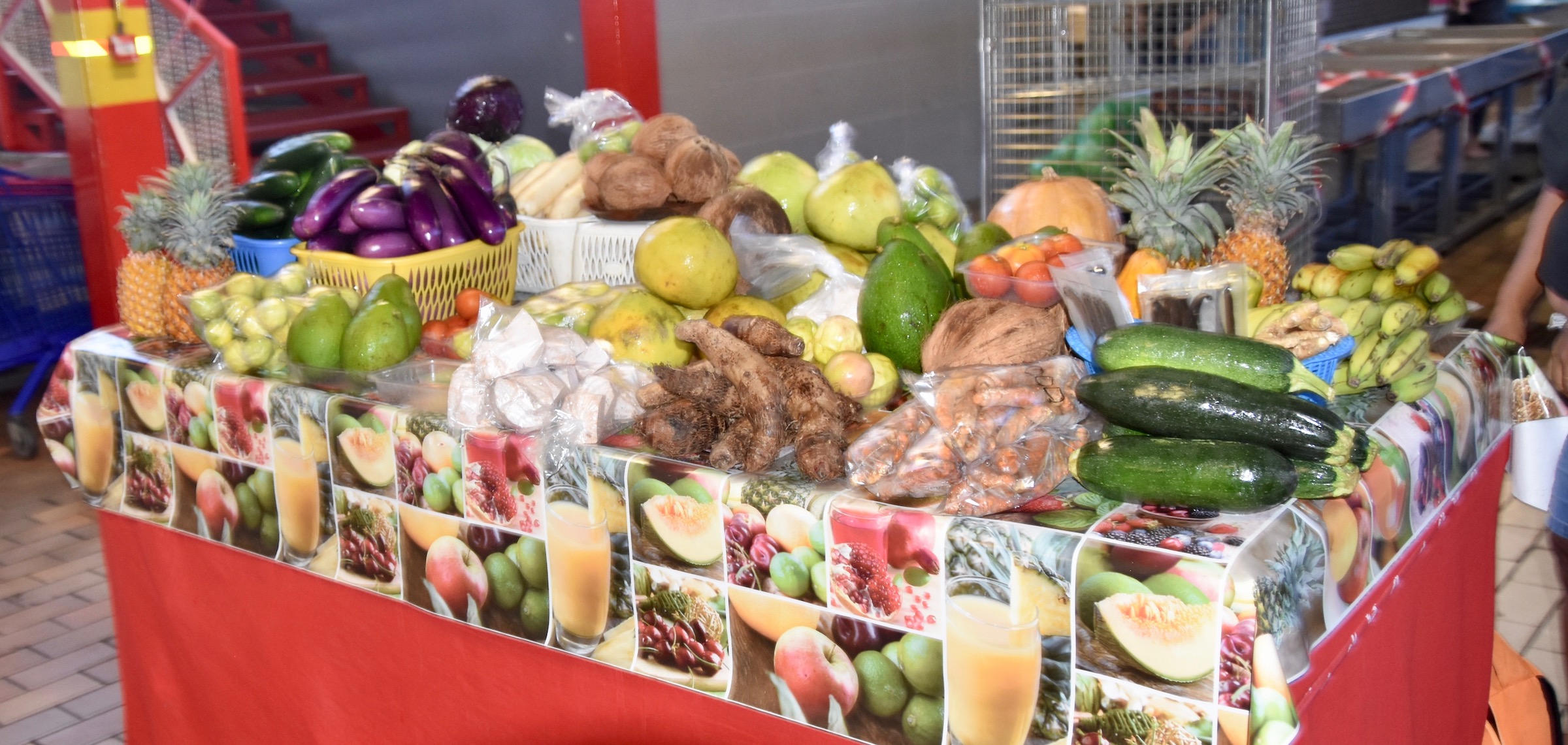
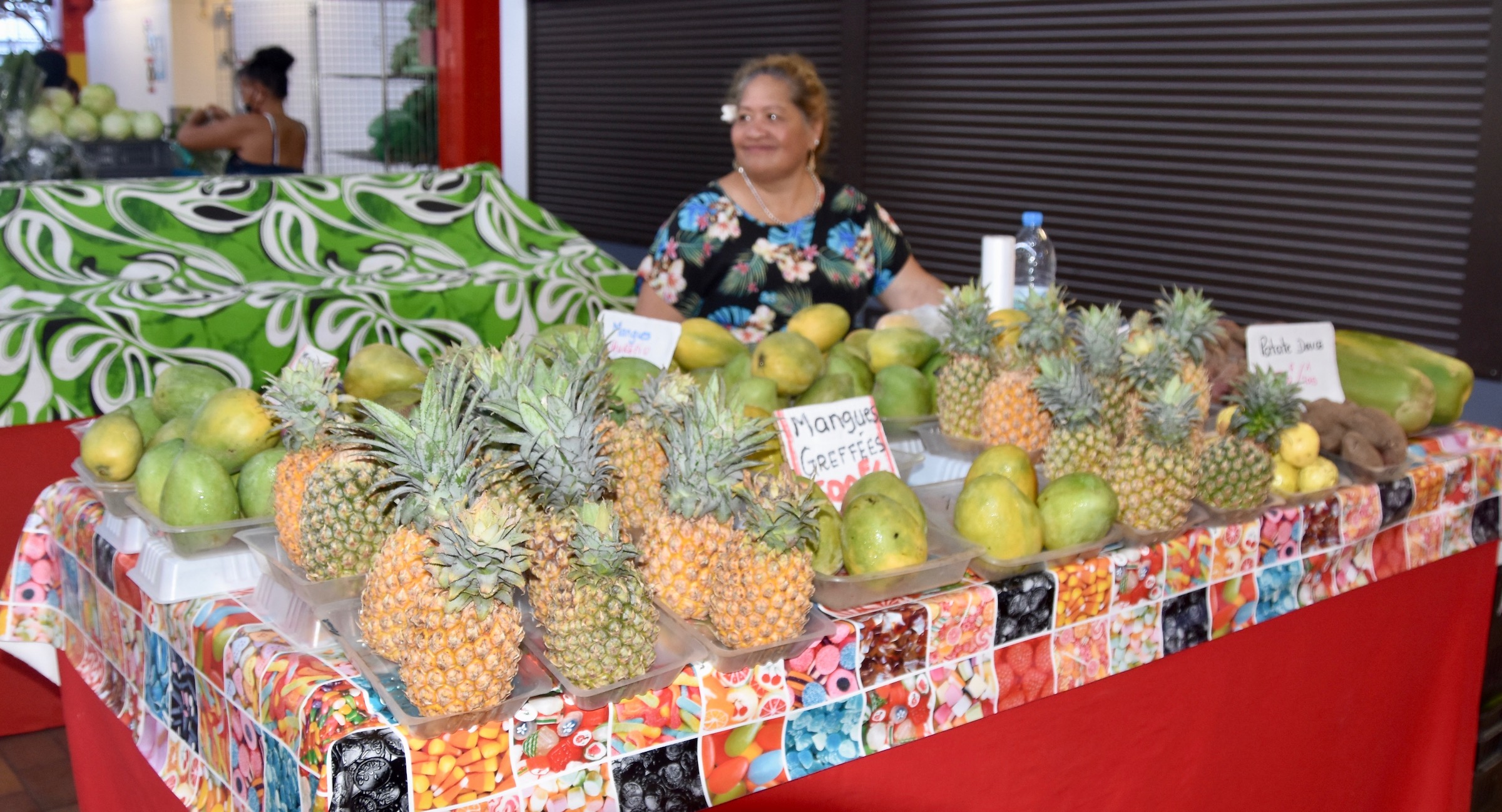
Another thing that might be unique to the Papeete market, at least on Tahiti, are the poi vendors. Everyone has heard of poi, but not many people could tell you what it actually is. Here, looking down at our group from the second story, Gerard explains that poi encompasses a wide variety of foods made from fruits and vegetables and that it varies from one South Pacific nation to another. The one thing that is constant is that whatever the poi is made from, whether it be taro root, plantain or breadfruit, it is all ground to a fine consistency by a pestle. In the coming days we were to see the pestle time and again, so don’t confuse it with some type of phallic symbol.
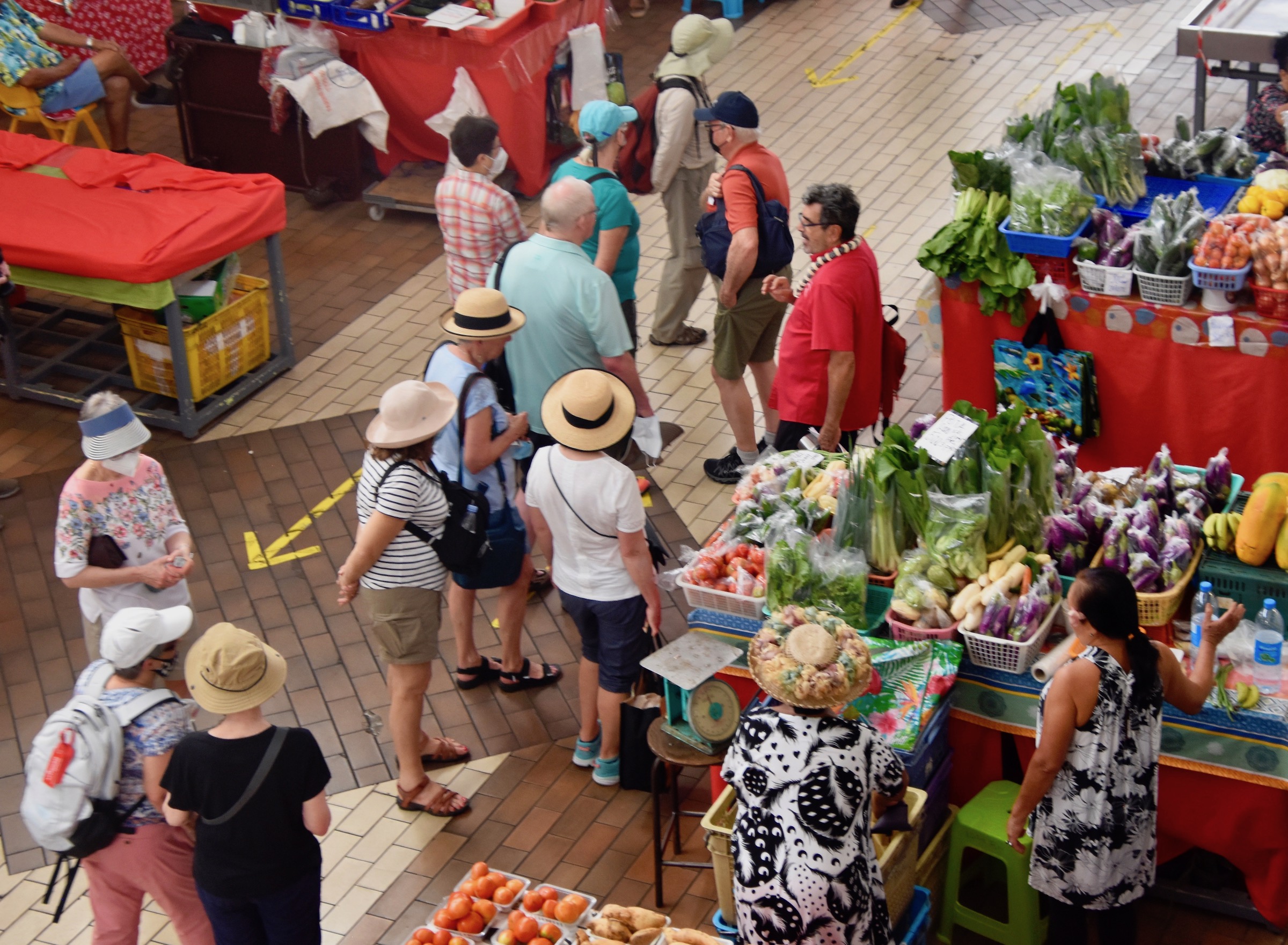
After the explanation about poi, Gerald led us to a poi vendor where we got to taste a number of varieties. Apparently the fresher it is the sweeter it will be and over time it will ferment into a more bitter taste. Fresh or not, it is definitely an acquired taste.
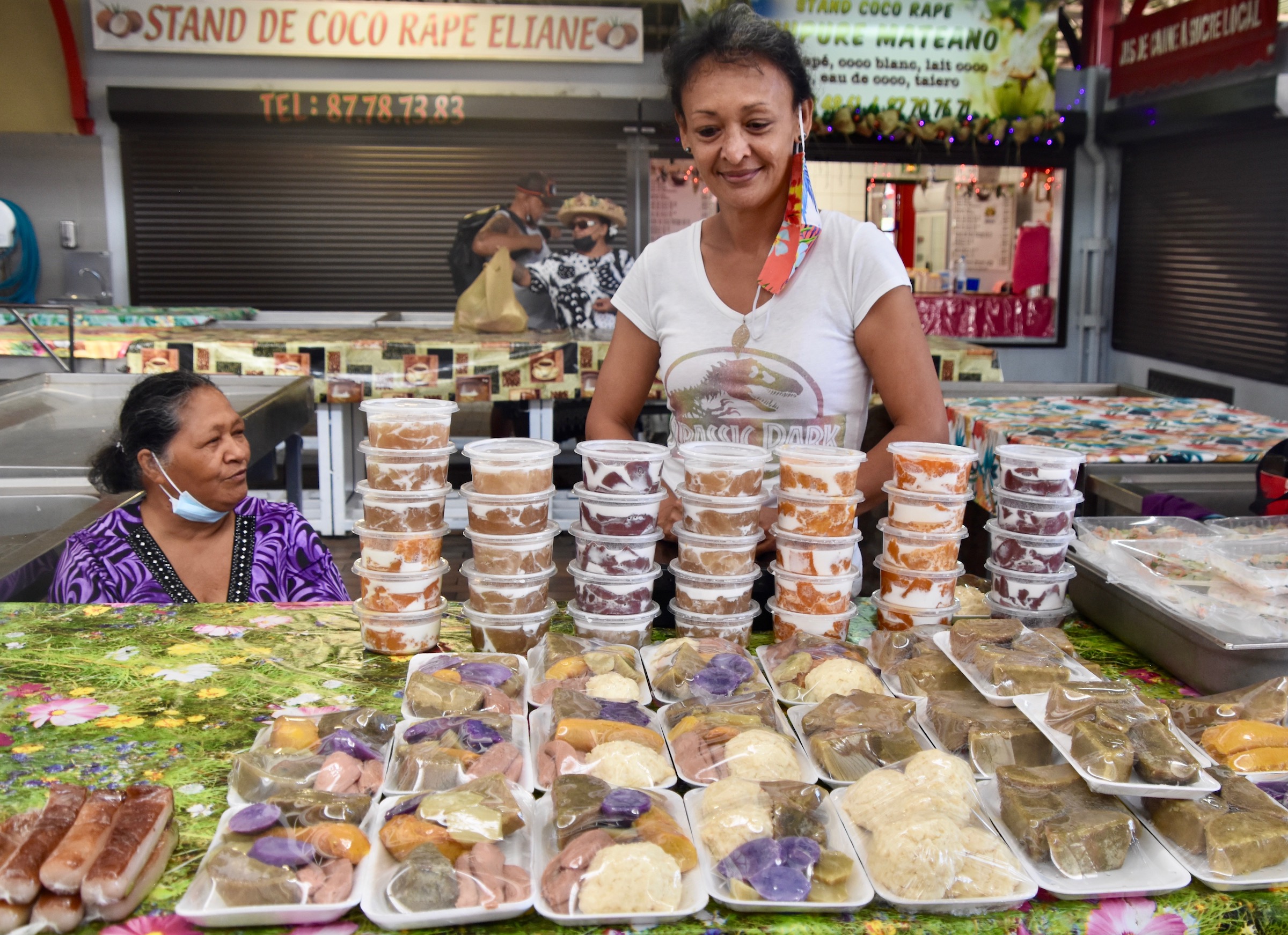
This is a map of Tahiti showing the very few roads on the island. Essentially the island is divided into two parts, Tahiti Nui which is the large part that is completely encircled by a highway and the much smaller Tahiti Iti which is joined to Tahiti Nui by a tiny isthmus.
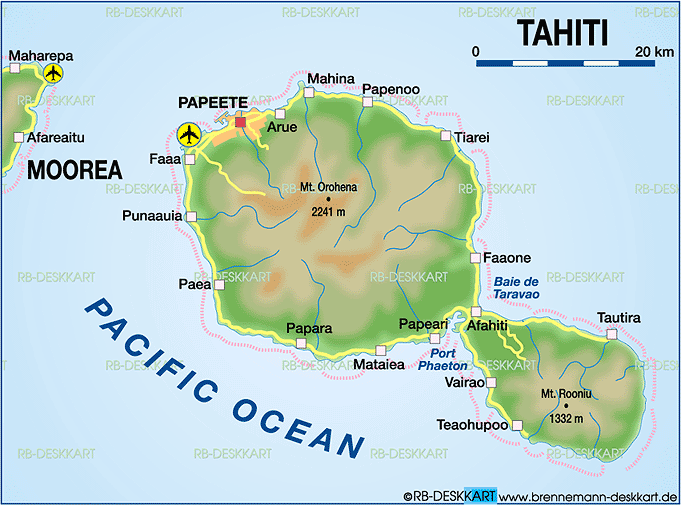
After visiting the market we head out in a counterclockwise direction towards the village of Paea where will have our next stop. Once we get away from the city the highway is basically two lanes and the traffic is steady, but not heavy. On the way we pass what Gerald says is the oldest church in Tahiti.
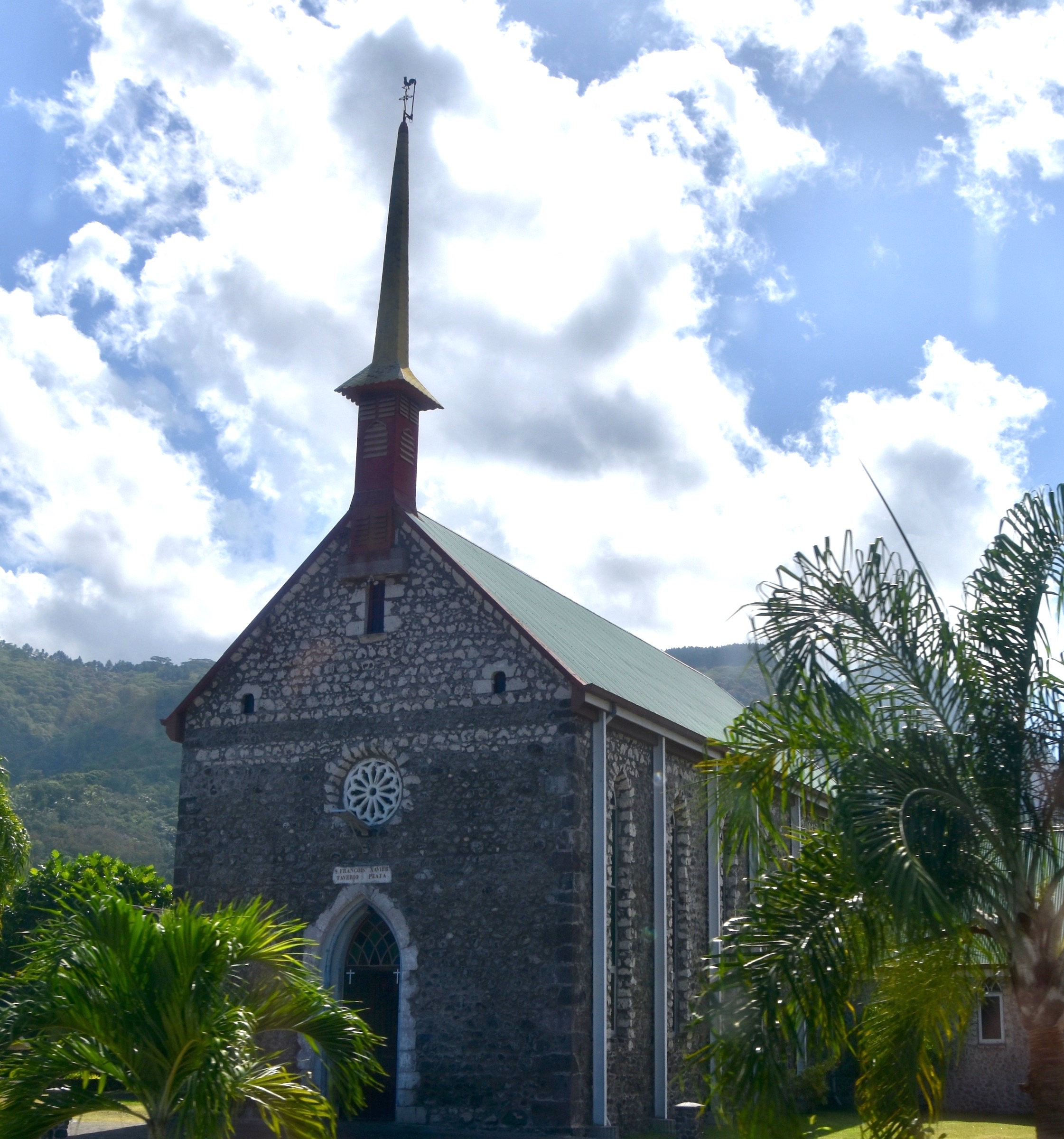
Marae Arahurahu, Tahiti
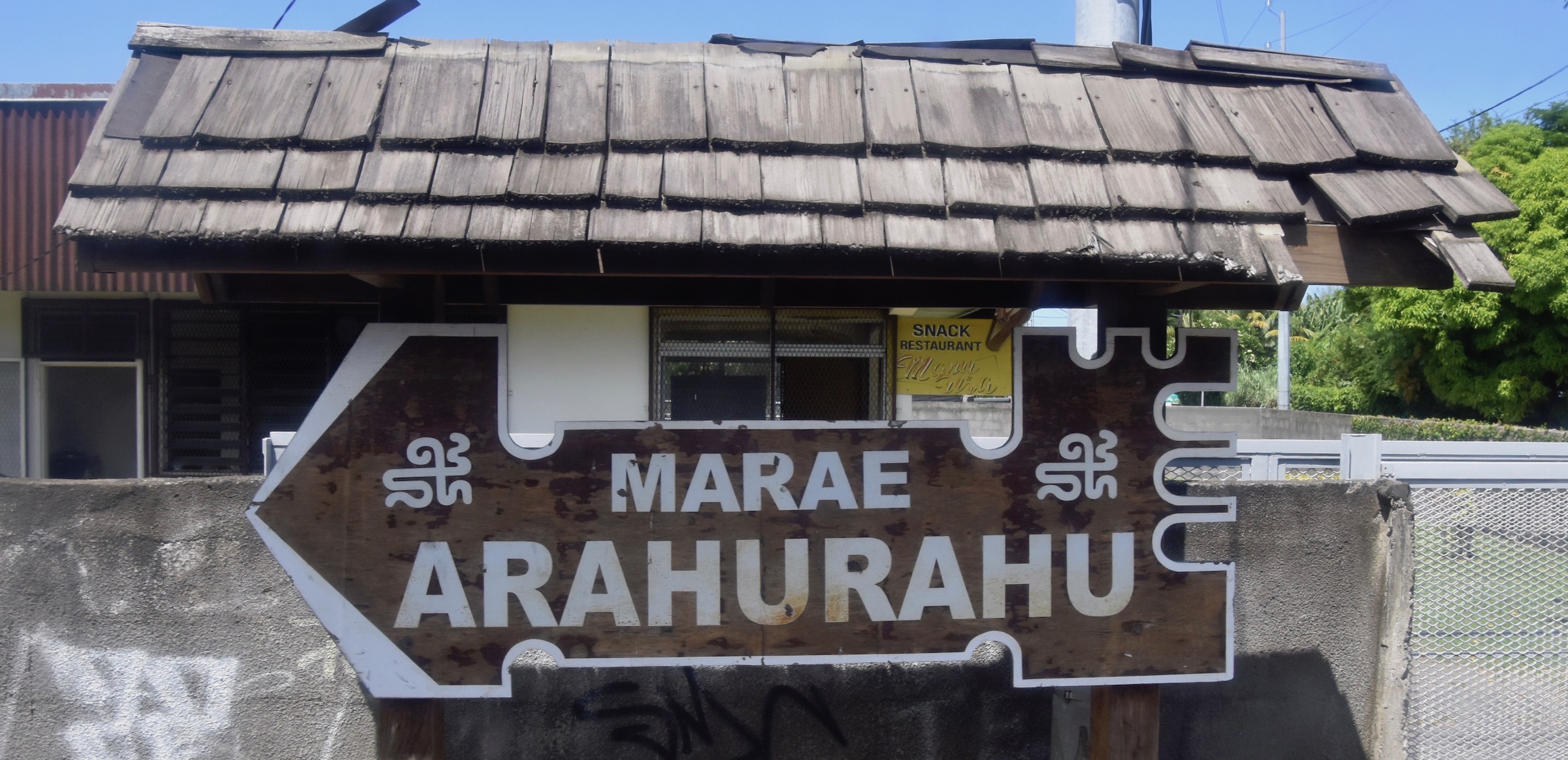
Our first outdoor stop was at the archaeological site of Marae Arahurahu, which I would not appreciate until after the trip was over, is the most representative Polynesian archaeological site we would visit. A marae is essentially a sacred complex equivalent to an ancient Greek or Roman temple in terms of the import to the people that built it. This marae was once the centre of power for the most powerful ruler in Tahiti, but once the ‘Christians’ arrived they had it destroyed as they did to virtually every religious site in French Polynesia. The Protestant missionaries were particularly known for their zeal in destroying these places and building churches atop them. They also had an incredible talent for shaming the islanders into helping them commit the vandalism and turning their backs on their own belief systems that had developed over thousands of years. OK, some of the things like human sacrifice and cannibalism deserved to be stopped, but that did not mean that their entire pre-European contact ways needed to be trashed.
After all this cultural mayhem had occurred in the 18th, 19th and well into the 20th century, people started to realize what had been lost. The Bishop Museum in Honolulu, which is probably the best place in the world to learn about Polynesian culture, decided to restore some of what had been desecrated. In 1953 they chose Marae Arahurahu as their first restoration project.
Consistent with what I had experienced in Malta and Turkey since the start of Covid, there were no other tourists at this site. We disembarked and just before entering the site Gerald pointed out a noni tree and picked off one of its fruits. I didn’t have a clue what the hell a noni tree was or what its fruit was used for. As he explained, it is the main ingredient in the production of Noni Glow Face Oil which is being touted as the latest wonder product for making your face and neck appear forty years younger than you actually are. Looking at prices for this product on Amazon you can get it for only about twenty times what you just paid for the monoi oil (which actually works) at the Papeete market. No wonder Gerald looks confused.
PS Notice Elaine in the foreground with the floral wreath she bought at the market.
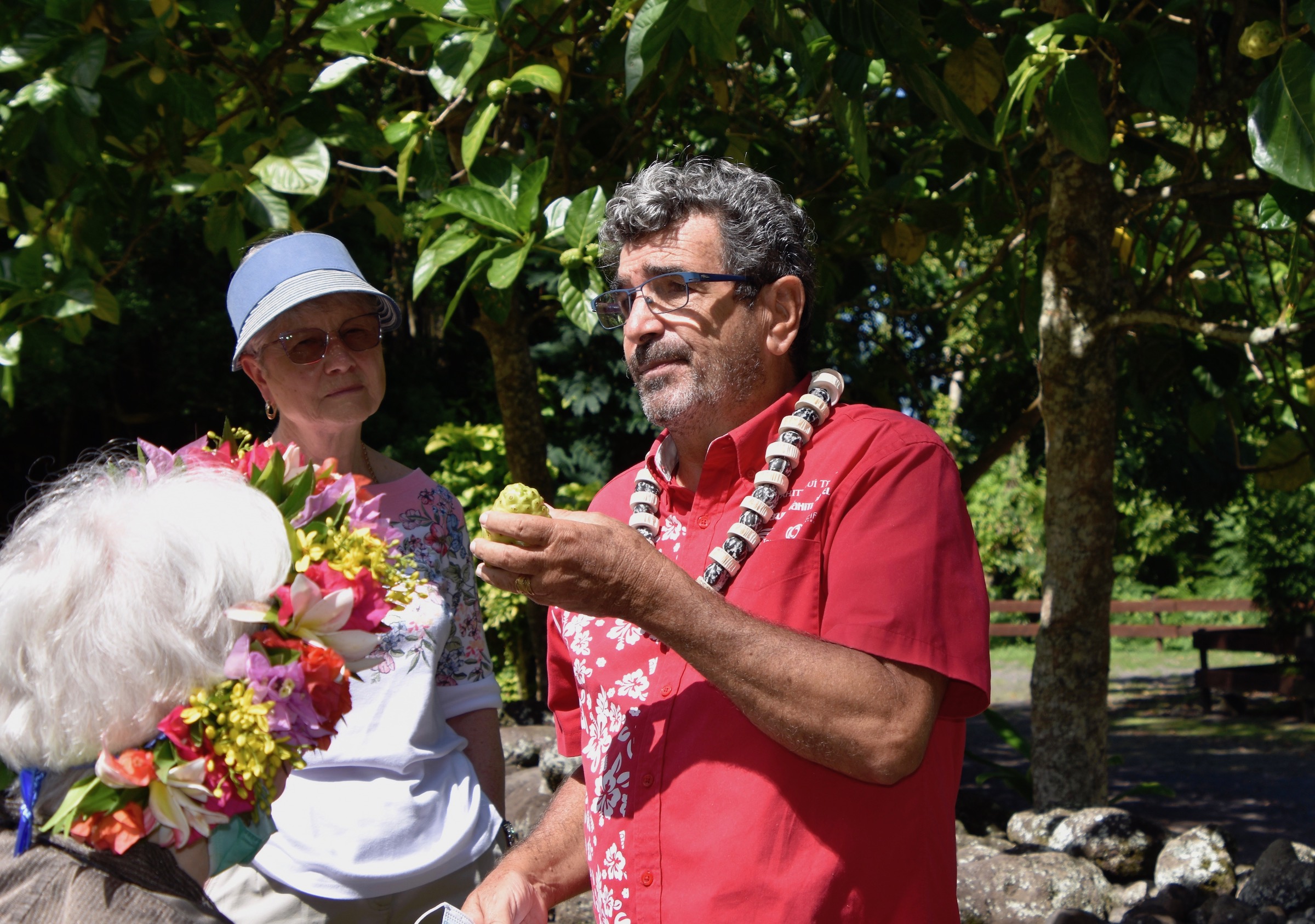
This is the scene that you see as you first enter Marae Arahurahu. Gerald explained that the figures made from stone are called moias of which those on Easter Island are the most notable examples, but they exist in less grand forms throughout Polynesia. Moias are to be distinguished from tikis which are made of wood, while the moias are always stone, he said. However, almost every where else we saw moias on this trip the guides would call them tikis. Personally, based on his overall knowledge, I’ll take Gerald’s word.
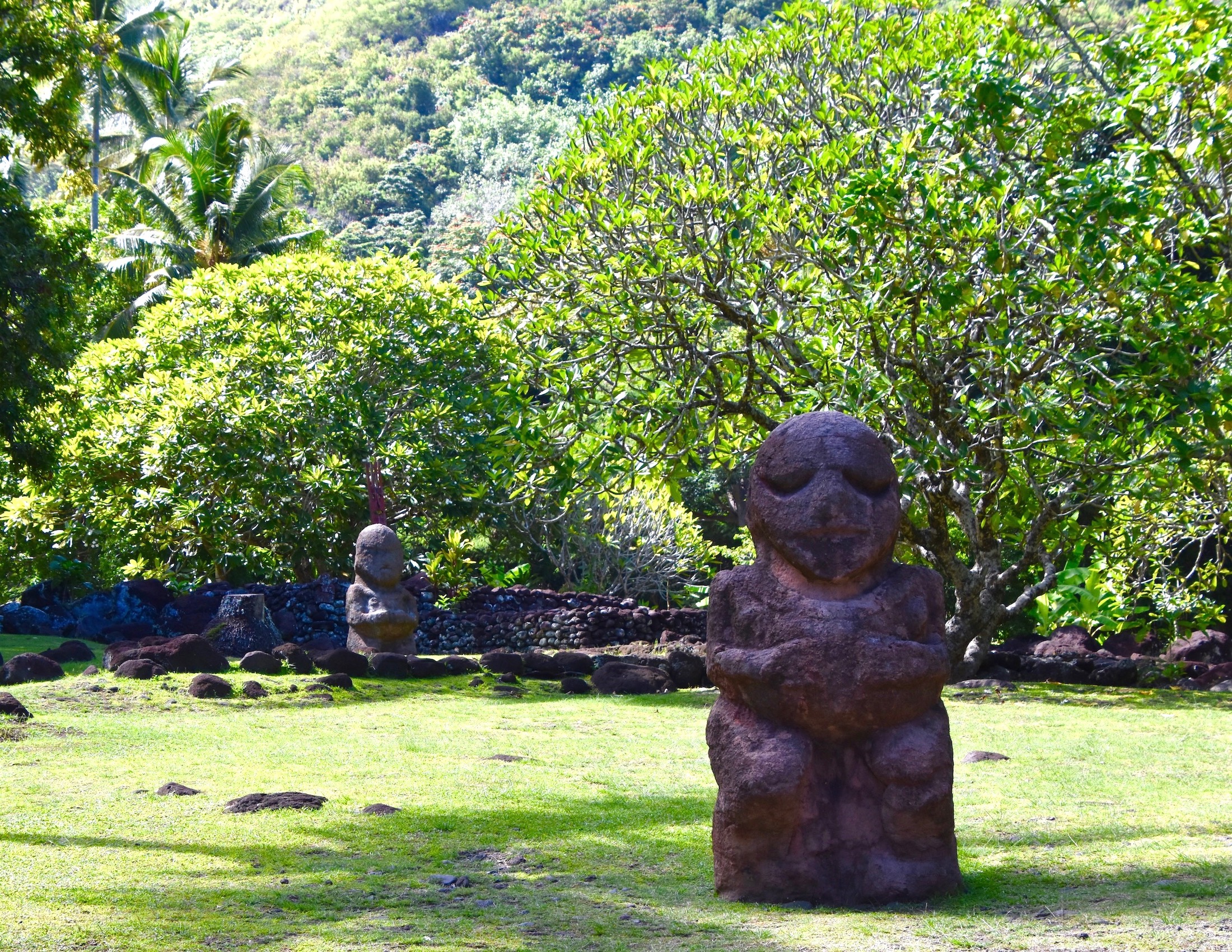
So here I am with a moia, not a tiki.
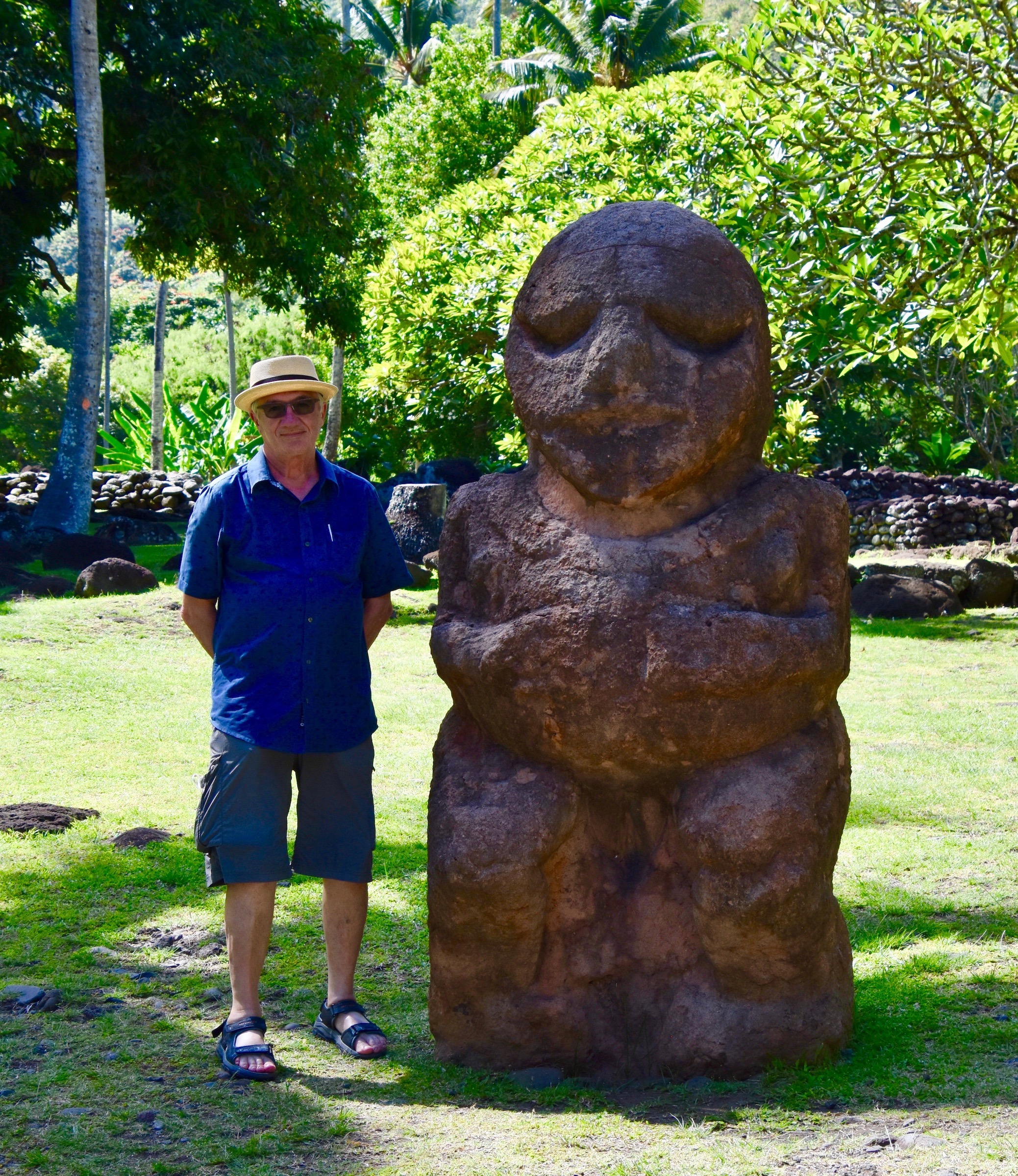
This is the approach to the raised altar or temple called the ahu.
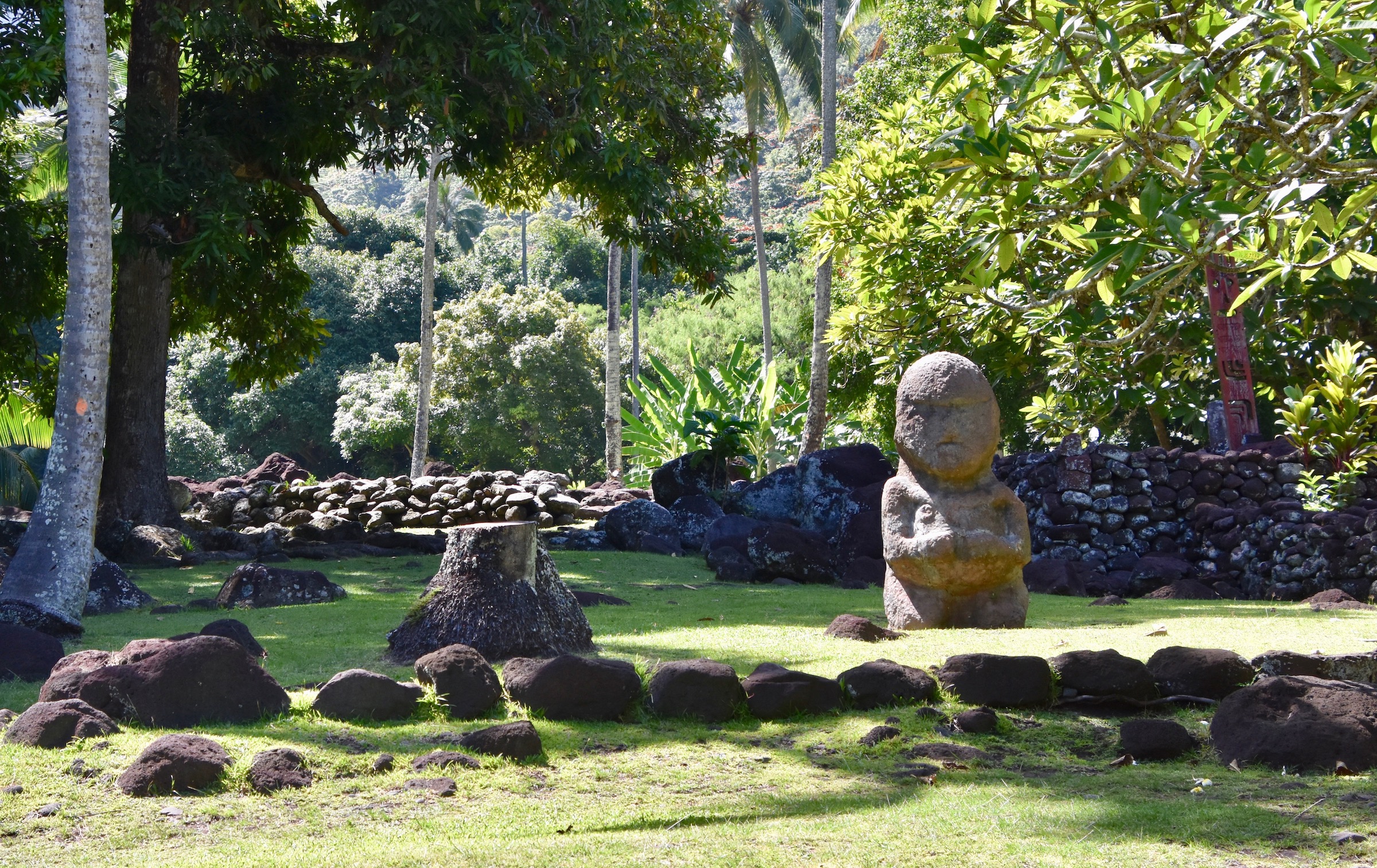
It’s a very tranquil spot today, but it wasn’t always so as Gerald explains while standing in front of the ahu. Captain Cook landed on Tahiti in 1769 at a spot we will visit later today, but ultimately he was brought here to meet the top Tahitian dog. He was greeted warmly and a feast was held in his honour. A stranger from another village happened to be passing by and he was invited to join the festivities which he readily agreed to. As he approached the ahu a warrior brained him from behind with one of the fearsome war clubs that were the weapon of choice of the Tahitians. The stranger keeled over dead whereupon the chief plucked out his eyeballs and handed them to Cook as a delicacy. Cook documented all this, but never revealed if he ever actually ate the eyeballs or any of the flesh of the roasted stranger that was offered to him.
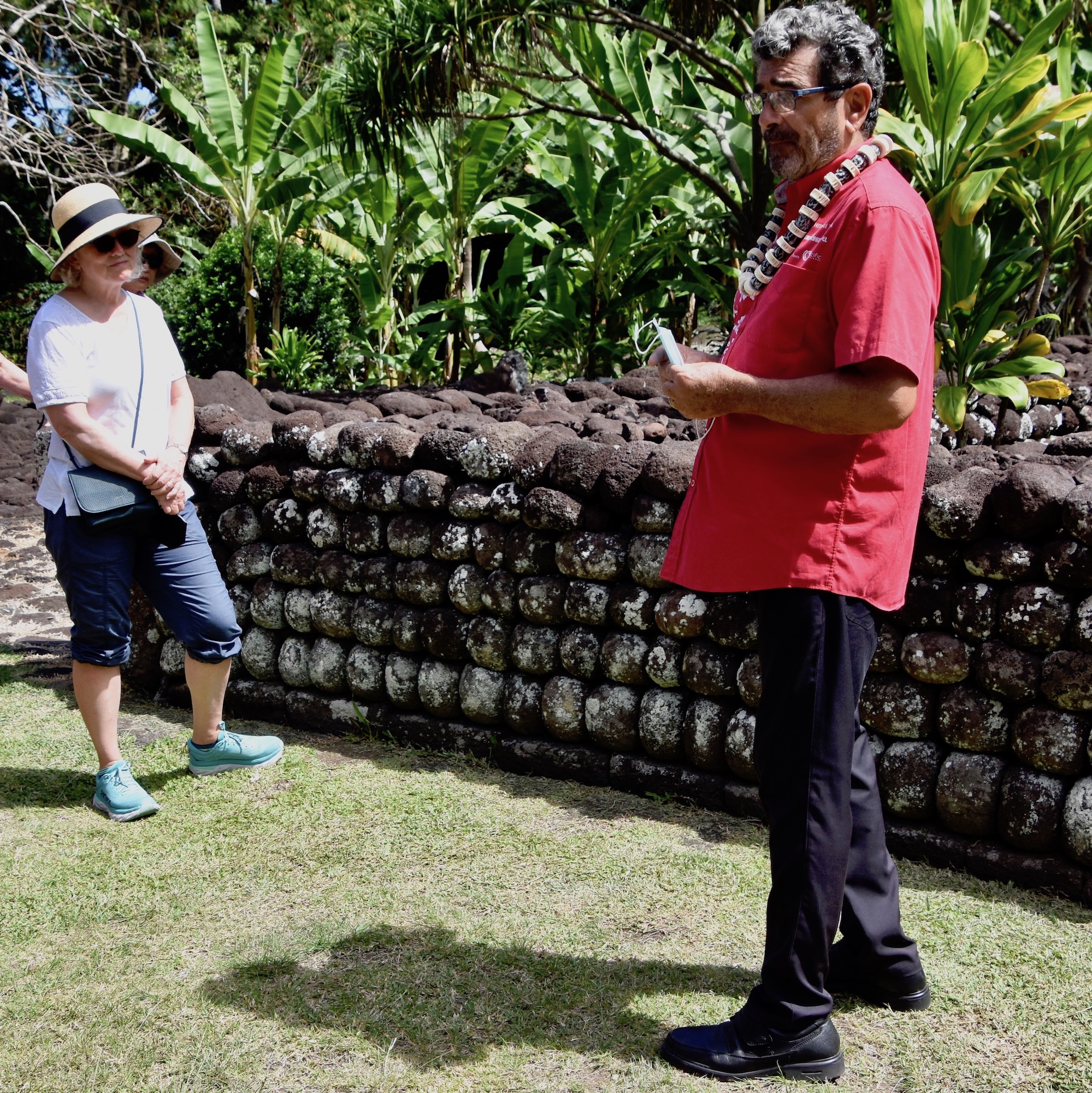
Looking at the ahu today you would not think that it once ran read with the blood of sacrificial victims. This place is still sacred to Indigenous Polynesians and every year events associated with the Heiva Festival are held here and other locations on Tahiti. It is a month long competitive event that features dancing, singing, fire walking and many other traditional events that draw competitors from across French Polynesia. Like many traditions like the ghost dance in North America, heivas were forbidden by the European overlords for many years. However, the tradition was revived in 1881 and today is widely known as “The Best Festival You Never Heard Of”.
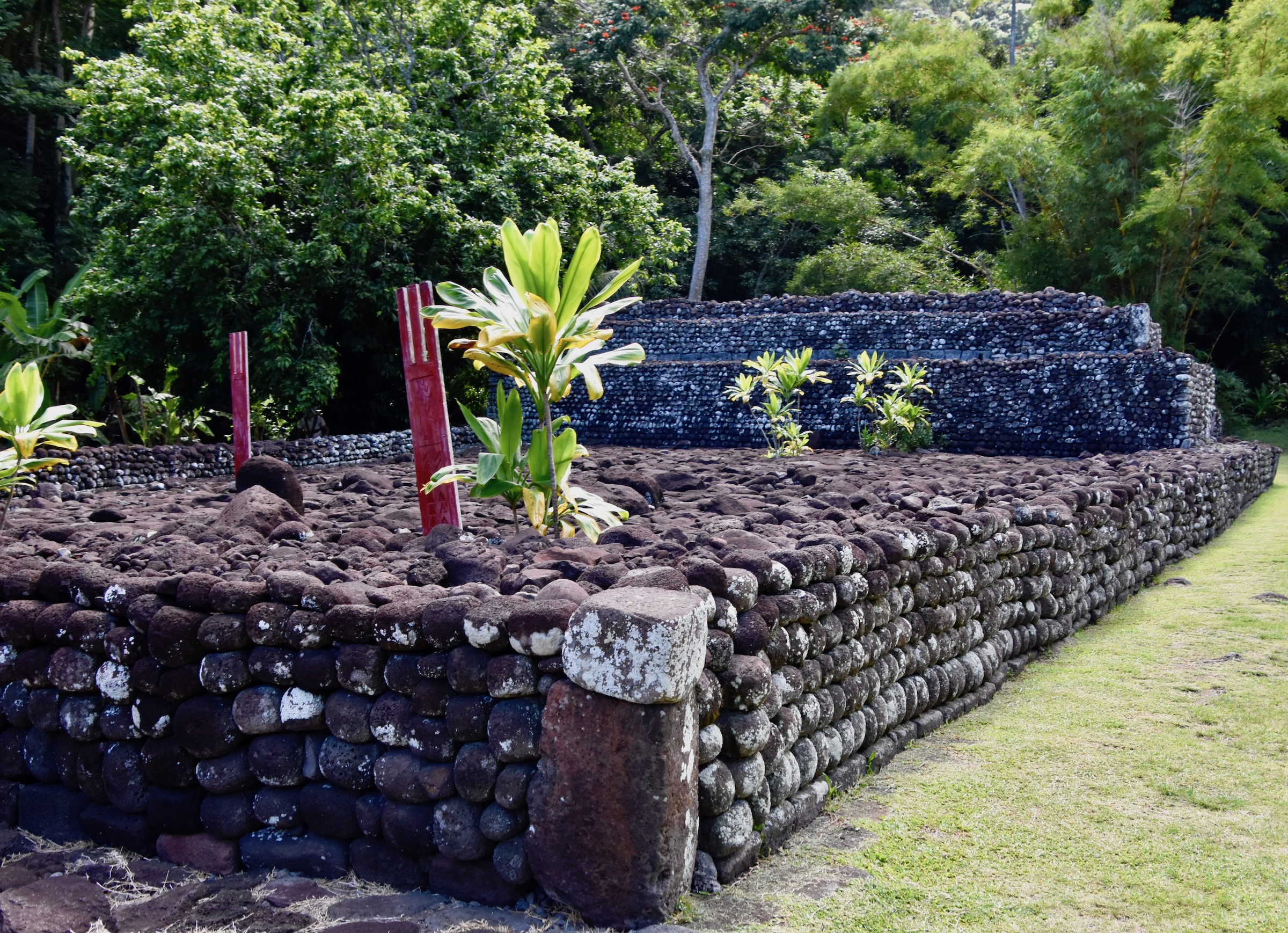
BTW, it is strictly tabu for any foreigner to climb up onto the rocks of the ahu. To do so will bring bad luck not only to the trespasser, but all of those in that person’s immediate circle. So if you visit this place with family or friends and one of them attempts to climb onto the ahu make damn sure you tackle them first.
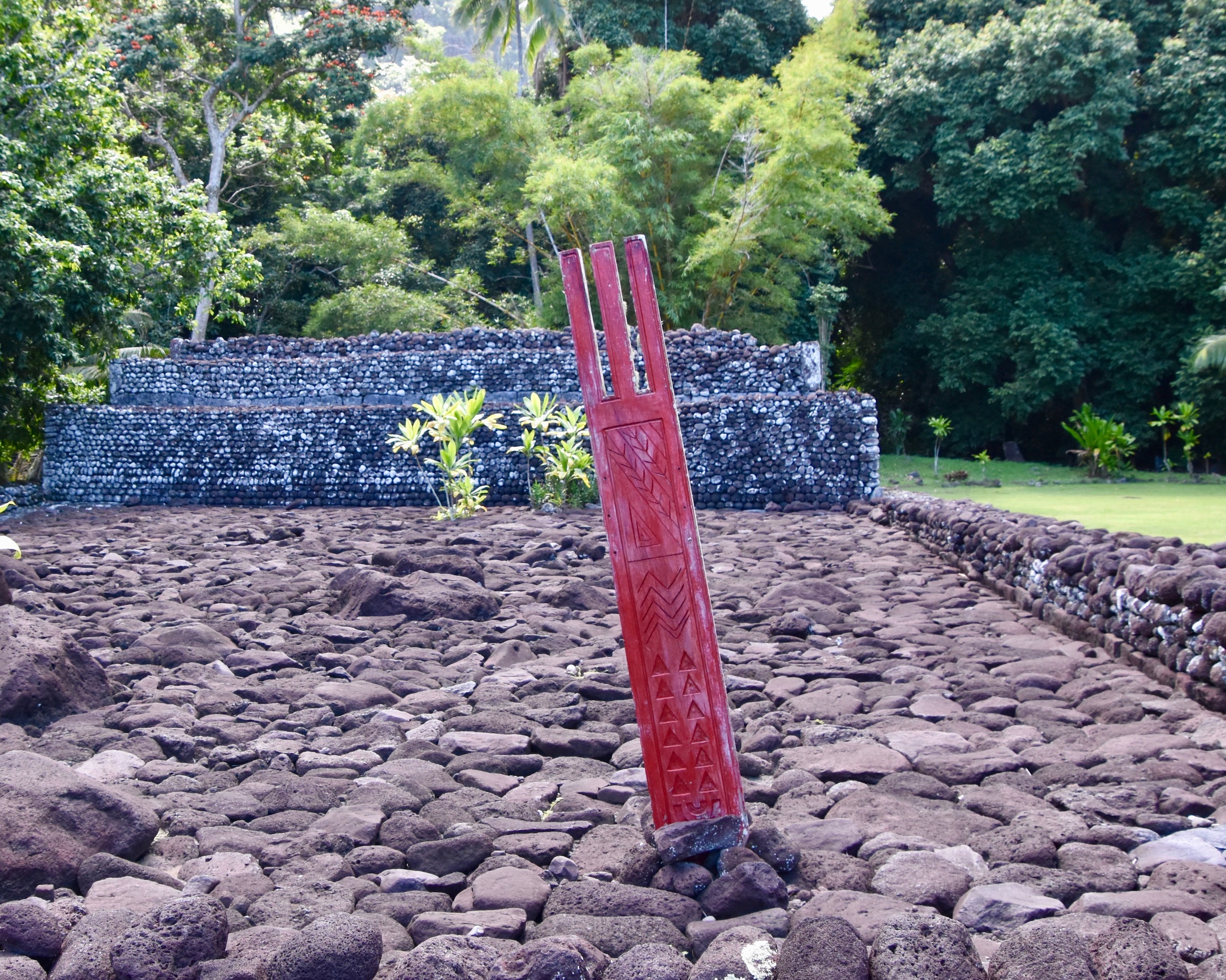
There were several of these red wooden board like structures on the ahu which Gerald said were tikis. They come in both the more common humanoid form we are all familiar with and zoomorphic form which the one above represents. In many Polynesian cultures the word ‘tiki’ is the name of the first man, literally the Adam of the race. In Tahiti the actual word for this man is ti’i and he is said to be made from red earth, this the red colour of both humanoid and zoomorphic tikis. You can learn a lot by listening to Gerald.
He has one more story before we leave Marae Arahurahu, but it has nothing to do with events that took place here, but rather another type of tree that just happens to be growing right beside the ahu.
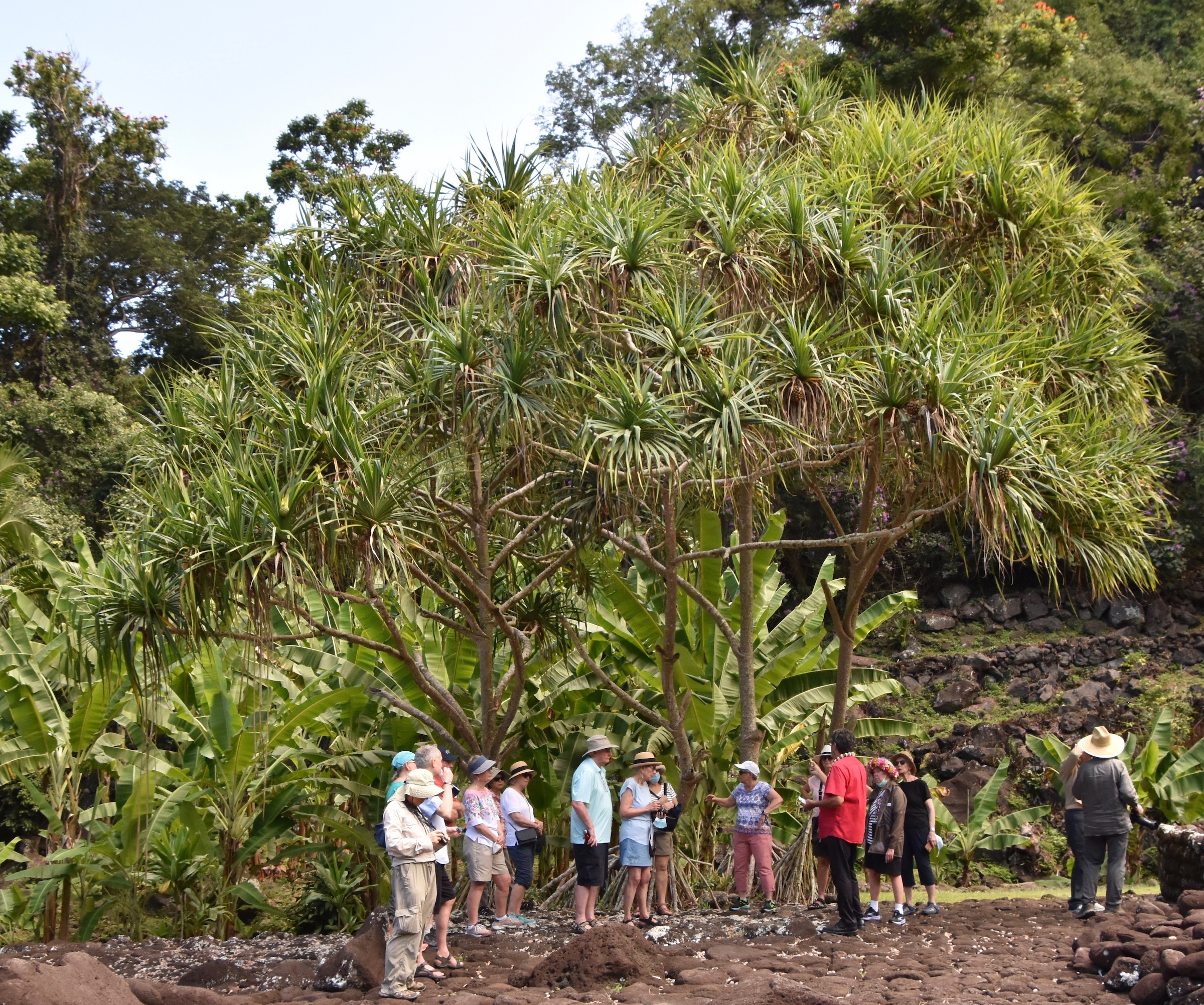
This is a hala tree which is found throughout the Pacific region and it comes in both a male and female version. This is a male plant which produces a flower known as a hinano. If that words seems familiar it’s because within a few days of landing in Tahiti you will see it everywhere as it is the name of the most popular beer in French Polynesia. The logo of Hinano beer is this beautiful seated woman and it is as ubiquitous in Tahiti as the Coca-Cola logo is everywhere else.
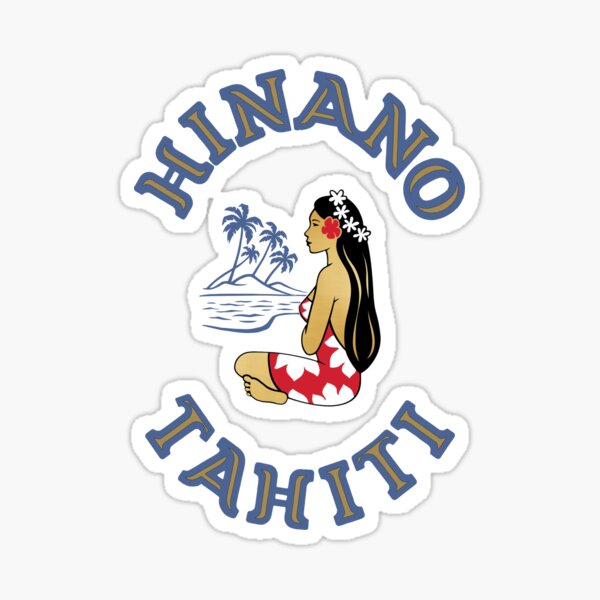
It turns out that the Tahitians originally made an alcoholic drink from the hinano flowers which Gerald explained was virtually undrinkable, it tasted so bad. However, when looking for a name for their new beer in 1955 the brewers opted for hinano, its reputation as a truly Tahitian drink overcoming its disreputability as something you would actually want to drink.
We’ve got a lot more places to see on this tour of Tahiti and I’ll continue our trip around the island in the next post. I hope you’ll stay on board.

